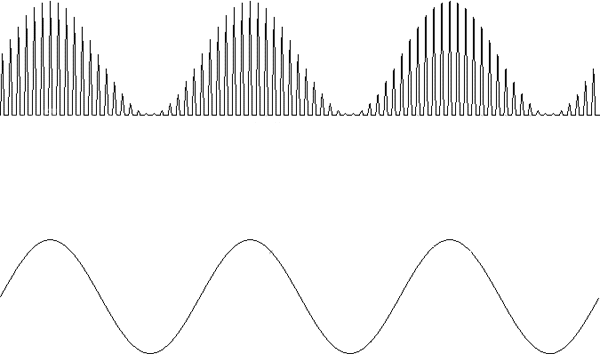AMPLITUDE MODULATION
How it works.
We know that something as simple as a crystal diode (rectifier) can be used to capture sound from the air and put it into a pair of earphones or an amplifier and speaker. How can this work? We will cover that here and now. All AM (Amplitude Modulation) detectors work basically the same way.What is AM?
What we can hear as audio is classically considered to be the frequency range between 20 and 20,000 cycles per second (here after referred to as "cycles" and abandoning "hertz") which I have never liked). In reality most adults can only hear up to about 13,000 cycles. Most speakers can't reproduce anything lower than 30 cycles in spite of the exaggerated claims of proud owners. So let's be generous and call audio 30 to 15,000 cycles.Radio frequencies are between 8,000 cycles and 50,000 megacycles. That's right there is a range of frequencies that depending on how they are treated can be audio or radio. The AM radio band begins at 540 kilocycles.
For simplicity let's say that we want to transmit a 10,000 cycle tone on a radio transmitter operating on 250 kilocycles.
The 250 kc transmitting frequency is called the carrier wave because it may be thought of as carrying the audio.
For those who know that this is not the case, I know that also. This is a greatly simplified version of AM.The 10,000 cycle audio frequency is called the modulating frequency. If you want to get into side-bands, click here.

For a verbal description click here.
In the figure above the upper wave is the modulating wave and three cycles of it can be seen. The lower wave is the modulated carrier wave and 75 cycles are visible. (You can count them for yourself or take my word for it.)
Notice as the modulating wave goes up the total amplitude of the carrier wave (measured from negative peak to positive peak) goes up. As the modulating wave goes down the amplitude of the carrier wave goes down. When the modulating wave is at zero (the point where it begins and ends) the carrier wave is at its middle or unmodulated value. Think of the modulating wave as controlling a valve that the carrier wave is passing through. (I have direct conformation from England, that's why the British call tubes valves.)
The carrier wave can then be sent to an antenna which radiates it out for all the world to hear.
Detecting the signal
Detection is the word applied to the process of recovering the audio frequencies from the radio frequency carrier. In the case of amplitude modulation it is very simple. All we need to do is to rectify the signal. Rectification is the process used in power supplies to change AC to DC. It's really quite similar for detecting radio signals. Compare the carrier wave in the figure below with the one in the figure above.

For a verbal description click here.
The wave has been run through a rectifier which removed the bottom half of every cycle. If we draw a line connecting the peaks we have the original modulating signal back again. Connecting the peaks is done by using a capacitor to charge up to the peak value and discharge through a resistor just fast enough to follow the modulating frequency but not so fast as to cause a large variation at the carrier frequency.
The frequencies chosen for this drawing are fairly close together to make it possible to see the individual cycles on your computer screen. When dealing with the AM broadcast band the carrier frequencies range from 540 kc to 1600 kc. 10,000 cycles is the absolute upper limit for audio on AM and most transmitters only make it to about 8,000 cycles.
Look back at the diagram of the crystal set. Use your back button to return here. If you are familiar with power supply circuits you will recognize it as a half wave rectifier with a capacitor to filter out ripple. The resistor makes the capacitor discharge just fast enough but not too fast.
A much more rigorous discussion of AM, including side bands, is available by clicking here. This includes not only AM but SSB and FM.
This page last updated May 13, 2002